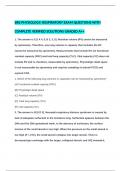Exam (elaborations)
BRS PHYSIOLOGY: RESPIRATORY EXAM QUESTIONS WITH COMPLETE VERIFIED SOLUTIONS GRADED A++
Institution
BRS PHYSIOLOGY
BRS PHYSIOLOGY: RESPIRATORY EXAM QUESTIONS WITH COMPLETE VERIFIED SOLUTIONS GRADED A++
1. The answer is E [I A 4, 5, B 2, 3, 5]. Residual volume (RV) cannot be measured by spirometry. Therefore, any lung volume or capacity that includes the RV cannot be measured by spirometry. Measurements that in...
[Show more]
Preview 3 out of 19 pages
Uploaded on
November 14, 2024
Number of pages
19
Written in
2024/2025
Type
Exam (elaborations)
Contains
Questions & answers
All documents for this subject (26)
R196,00
Also available in package deal from R1,09
100% satisfaction guarantee
Immediately available after payment
Both online and in PDF
No strings attached
Document also available in package deal (1)
PACKAGE DEAL OF BRS PHYSIOLOGY EXAM QUESTIONS WITH COMPLETE SOLUTIONS VERIFIED
R 2.687,93
R 1.093,60
14 items
1. Exam (elaborations) - Brs cell physiology exam questions and answers with complete solutions verified lates...
2. Exam (elaborations) - Brs cell physiology exam questions with verified answers graded a++
3. Exam (elaborations) - brs cell physiology exam questions and answers with complete solutions verified
4. Exam (elaborations) - Brs cell physiology exam questions and verified correct answers 100% guaranteed pass
5. Exam (elaborations) - Brs physiology exam questions with complete solutions verified
6. Exam (elaborations) - Brs physiology exam questions and answers with complete solutions verified latest upd...
7. Exam (elaborations) - Brs physiology: cell physiology exam questions and answers with complete solutions ve...
8. Exam (elaborations) - brs physiology exam questions and answers verified graded a++ latest update
9. Exam (elaborations) - Brs physiology- cell physiology exam questions and answers with complete solutions ve...
10. Exam (elaborations) - Brs gi physiology exam questions and answers with complete solutions verified latest ...
11. Exam (elaborations) - Brs cardiovascular physiology exam questions and verified answers
12. Exam (elaborations) - Brs physiology exam questions with complete solutions verified 2024/2025
13. Exam (elaborations) - Brs physiology-chapter 1 cell physiology questions and answers with complete solution...
14. Exam (elaborations) - brs physiology: respiratory exam questions with complete verified solutions graded a...
Show more
BRS PHYSIOLOGY: RESPIRATORY EXAM QUESTIONS WITH




